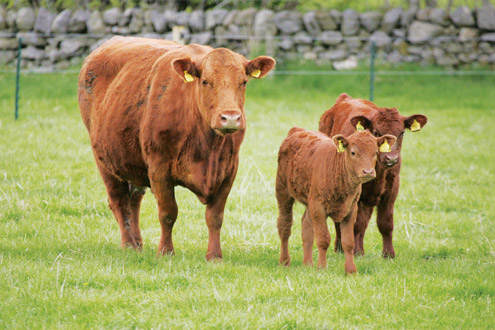Well-managed beef twinning can boost bottom line

Most beef producers would rather steer clear of twin births to avoid problems such as increased calf mortality. But there is a possibility the pros could outweigh the cons when managed correctly.
In 1981, the US Department of Agriculture started a beef twinning project at the US Meat Animal Research Centre (USMARC) in Nebraska. More than 30 years of research have proved selecting for twins has the potential to increase total beef production.
Brian Kirkpatrick from the University of Wisconsin, who has been looking at mapping genes contributing to twinning rate, says the benefit is simply increasing calf production relative to costs of cow maintenance, therefore increasing production efficiency.
Results from the USMARC project suggest it could be feasible to increase cattle twinning rates to economically viable levels. In the experimental twinning herd, the frequency of fraternal twin births (twins from two separate eggs), has increased from 3.1% a year to 50-55% in about 20 years through selection.
They found although twinning reduced calf survival, dams producing twins weaned 70.8% more calves than dams with a single birth. This resulted in a 48.1% increase (335.7kg versus 226.6kg) in total weaning weight.
Key considerations
However, twinning is associated with a number of negatives, including more abortions and retained placentas, longer interval before return to oestrus and reduced calf survival.
There is also a higher incidence of freemartin heifers. Twin-born calves have also been reported to be about 20% lighter at birth and about 10% lighter at weaning than single-born animals.
Dr Kirkpatrick believes the key to exploiting twinning is to make the most of ultrasound scanning.
Samuel Boon from EBLEX says twin-bearing cows will need about 13% more energy, so scanning will identify cows that will need higher-energy diets.
“Twinning cows also require more careful observation at calving because although smaller twin calves will reduce calving difficulties, malpresentation tend to increase. Early weaning may also need to be considered to give cows time to recover body condition,” says Mr Boon.
Producers will also need to carefully record freemartin heifers to prevent them being accidently retained and also be aware as the level of twinning increases, so does the likelihood of triplets.
So, how could we introduce the twinning trait into UK herds? Twinning may be a way to increase profitability, but only on a farm that has a well-managed, profitable herd with high reproductive performance and low calf death losses, stresses Dr Kirkpatrick.
Mr Boon says it’s important to plan carefully and see whether twinning stacks up financially. “There’s no point if the extra calf is dying or you’re losing the productive life of the dam,” he says.
If a UK farmer decides to select for twinning, Mr Boon suggests the following:
• Decide which breed is sensible – for example, a maternal line with a reasonable amount of milk
• Approach the UK breed societies and ask for data on twinning incidence. You could get the raw data of cows, but ideally you’d want to find bulls that had sired twins
• You could import genetics from an established line, such as the USMARC Twinning Herd. This is an open composite herd, so a farmer would have to be unconcerned about breed
• Consider doing a bit of both – select for twin genetics from the UK and import some from an established line
• You could advertise for cows that are proven twinners
| Case study: Les Marsh, Coalville near Salt Lake City, Utah |
|---|
| North American beef farmer Les Marsh has been selecting for twinning traits in his herd of 20 cows for 25 years and has since increased twinning rate from 5% to more than 50%. “I started selecting for twinning to increase production from my small number of cows,” he explains. Mr Marsh has been able to boost cow prolificacy by artificially inseminating using semen from bulls with high genetic figures for the twinning trait and now has a herd of North American Twinners produced by using genetics from the USMARC Twinning Herd. “The weaning weight of twin calves is only about 22kg lighter than single calves,” says Mr Marsh. “The only negative I have is keeping enough heifers for replacements, because the twin heifers born with a bull twin are freemartins. “I would recommend twinning to beef producers who are willing to make the effort to make it work,” he says. |
Hear how Farmers Weekly/Harper Adams beef focus farmer Simon Frost maximises production
